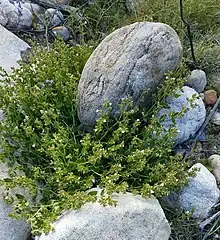Mirabilis tenuiloba
Mirabilis tenuiloba common names longlobe four o'clock[1] or maravilla, is a plant species native to the south-western United States and north-eastern Mexico. It has been reported from Baja California, Baja California Sur, southern California (Riverside, San Bernardino, San Diego and Imperial Counties) and Arizona (Pima and Yuma Counties).[2][3]
| Mirabilis tenuiloba | |
|---|---|
 | |
| Scientific classification | |
| Kingdom: | Plantae |
| Clade: | Tracheophytes |
| Clade: | Angiosperms |
| Clade: | Eudicots |
| Order: | Caryophyllales |
| Family: | Nyctaginaceae |
| Genus: | Mirabilis |
| Species: | M. tenuiloba |
| Binomial name | |
| Mirabilis tenuiloba | |
| Synonyms | |
|
Hesperonia tenuiloba (S. Watson) Standl. | |
Mirabilis tenuiloba is a perennial herb up to 100 cm tall, usually with many glandular hairs. Leaves are broadly egg-shaped, up to 8 cm long and 12 cm across. Flowers are trumpet-shaped or bell-shaped, white or pale pink, up to 18 mm long. Fruits are egg-shaped, dark red-brown, up to 6 mm long.[2][4][5][6][7]
References
- "Mirabilis tenuiloba". Natural Resources Conservation Service PLANTS Database. USDA. Retrieved 13 July 2015.
- Flora of North America v 4 p 49, Mirabilis tenuiloba
- Biota of North America Project, Floristic Synthesis, Mirabilis tenuiloba
- Watson, Sereno. 1882. Proceedings of the American Academy of Arts and Sciences 17: 375.
- Standley, Paul Carpenter. 1909. Contributions from the United States National Herbarium 12(8): 363.
- Shreve, F. & I. L. Wiggins. 1964. Vegetation and Flora of the Sonoran Desert 2 vols. Stanford University Press, Stanford.
- Hickman, J. C. 1993. The Jepson Manual: Higher Plants of California 1–1400. University of California Press, Berkeley.
This article is issued from Wikipedia. The text is licensed under Creative Commons - Attribution - Sharealike. Additional terms may apply for the media files.
